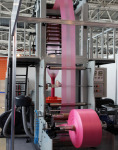There are a variety of plastics processing methods. Whether it’s injection molding (the most common), extrusion, blow molding, lamination, or other types, these processes make a multitude of items we use in our everyday lives. For simplicity, we will only concentrate on one of these methods today. Because injection molding is the most common process, we will discuss this type.
In injection molding, the plastic starts off in pellet or granule form. It is dropped into a hopper where it is fed into a barrel. Inside the barrel the plastic pellets melt and are fed towards the mold. Inside the mold, the molten plastic is cooled with either cooling tower or chilled water. This process cooling water is fed through many small channels within the mold. As the cooling water travels through the mold, it removes heat from the plastic, hardening it. When the cycle is complete, the mold opens and ejects the finished product. Inside these molds, plastic can be formed into a variety of shapes. You could make a garbage can, drinking cup, plastic fork, or even a computer case. The process, however, is simple. Feed the plastic into the hopper. It melts in the barrel. Travels to the mold where it is cooled and then ejected. Then the process starts all over again. Lather, rinse, repeat. Follow the link to see a video of Injection Molding in action.
It is a tricky balance between the temperature of your cooling water, the quality of your plastic and profitability. If you chill the plastic too cold, it cause defects. But the faster it’s cooled and ejected from the mold, the more product that can be produced and more profit that can be made. There is also a decision to be made between using cooling tower water or chilled water. While cooling tower water has a lower initial cost and operating cost, the water can become contaminated since it is an open loop (open to the environment). The chilled water from an air cooled chiller, on the other hand, is a closed system, so your molds are protected from possible debris and contaminants.
At the molding machines, a small unit called a thermolator, or temperature controller, helps to regulate the temperature of the cooling water going to the mold. While a single cooling tower or chiller can cool many molding machines, a thermolator is required at each machine. Since precise control to the molds is critical, these units are important to the overall process as well.
For more information on plastics cooling, contact our sales department at 281.540.2805 or visit www.smartcoolingproducts.com.


